Wind Speed Forecasts of a Mesoscale Ensemble for Large-Scale Wind Farms in Northern China: Downscaling Effect of Global Model Forecasts
Abstract
:1. Introduction
2. Data and Meteorology
2.1. Ensemble Numerical Weather Prediction System
2.2. The Observations and Forecasts
2.3. Evaluation Metrics
3. Statistical Verification Results
3.1. Characteristics of the Winds in the Region
3.2. Overall Performance of the Wind Forecasts
3.3. Variations of Forecast Errors with Wind Regimes
3.4. Diurnal Variation in Wind Forecast Errors
3.5. Forecast Errors in Seven Regions
- (a)
- The wind farms located on the northern slope of a mountain, with another mountain tens of kilometers to its northwest (Areas 1 and 3);
- (b)
- The wind farms located on valley passes or leeward slopes of mountains. (Areas 2, 4, and 5);
- (c)
- The wind farms located over relatively low terrain (Area 6);
- (d)
- The wind farms located over flat terrain away from significant mountains (Area 7).
3.6. Growth of Forecast Errors with Lead Time
4. Summary and Conclusions
- (1)
- Among the ensemble groups driven by the GFS, GEOS, and GEM global weather model forecasts, the GFS group significantly outperformed the other two groups with respect to the CC and MAE of the wind forecasts, with 59–64% of the turbines performing best. The GEM group was poorer overall, with only 2% of turbines achieving the best prediction. The wind forecast MAE of the GEOS group was similar to that of the GFS group, but the GEOS group tended to perform better in terms of BIAS. In the GEOS group, there were some larger positive and negative biases that offset one another, resulting in a smaller overall bias;
- (2)
- All three ensemble groups overestimated the low wind speed (0–3 m/s) and underestimated the high wind speed. All three groups had better forecasts for the wind speeds ranging from 3 to 12 m/s, and the errors of the GFS and GEOS groups were similar. For wind speeds greater than 12 m/s, the GFS group outperformed the GEOS group, and the GEM group had the largest error. The average deviation of the wind forecasts from the observations increased approximately linearly with the magnitude of wind speeds, reaching more than −4 m/s for the cases of strong winds over 15 m/s;
- (3)
- The wind speed forecasts of all three ensemble groups exhibited similar diurnal variation in each of the seven subregions. The wind forecast bias was generally small during daytime but overestimated by 1–1.5 m/s at night. The GFS group had the best performance, the GEOS group was slightly worse, and the GEM group significantly underestimated the wind speed during daytime. The GEOS group had more accurate wind speed forecasts than the GFS group in nighttime in several complex terrain areas;
- (4)
- The errors of the wind forecasts of the three ensemble groups increased with forecast lead time, with a growth rate of ~0.3 m/s for the 3-day forecast period. The nighttime MAE was 0.6–0.5 m/s higher than that in the daytime. The MAEs of wind forecasts of the GFS and GEOS groups were relatively close to one another, and the GFS group had a slight advantage. The wind speed forecast errors of the GEM group grew much faster at night, and its biases were ~0.4–0.6 m/s larger than those of the other two groups. The large MAE of the GEM group wind forecast during nighttime was mainly due to the systematic overestimation of wind speed at night;
- (5)
- Based on the results of this study, the ensemble outputs should first be processed to remove the bias of the three subgroups separately before they are combined for deriving probabilistic wind power forecast products. The model post-processing should be done for each region, as best as possible, for each wind turbine site independently, in order to deal with the unique forecast error properties of the ensembles in different regions. Model developers should devote their attention to mitigating the trend of the wind forecast bias growth with wind speeds.
5. Discussion
Author Contributions
Funding
Institutional Review Board Statement
Informed Consent Statement
Data Availability Statement
Acknowledgments
Conflicts of Interest
References
- Yu, L.; Zhong, S.; Bian, X.; Heilman, W. Climatology and Trend of Wind Power Resources in China and Its Surrounding Regions: A Revisit Using Climate Forecast System Reanalysis Data. Int. J. Climatol. 2016, 36, 2173–2188. [Google Scholar] [CrossRef]
- Makarov, Y.V.; Loutan, C.; Ma, J.; Mello, P.D. Operational impacts of wind generation on California power systems. IEEE Trans. Power Syst. 2009, 24, 1039–1050. [Google Scholar] [CrossRef]
- Georgilakis, P.S. Technical challenges associated with the integration of wind power into power systems. Renew. Sustain. Energy Rev. 2008, 12, 852–863. [Google Scholar] [CrossRef] [Green Version]
- Smith, J.C.; Milligan, M.R.; DeMeo, E.A.; Parsons, B. Utility wind integration and operating impact state of the art. IEEE Trans. Power Syst. 2007, 22, 900–908. [Google Scholar] [CrossRef]
- Shen, X.; Zhou, C.; Fu, X. Study of Time and Meteorological Characteristics of Wind Speed Correlation in Flat Terrains Based on Operation Data. Energies 2018, 11, 219. [Google Scholar] [CrossRef] [Green Version]
- Zhang, S.; Liu, Y.; Wang, J.; Wang, C. Research on Combined Model Based on Multi-Objective Optimization and Application in Wind Speed Forecast. Appl. Sci. 2019, 9, 423. [Google Scholar] [CrossRef] [Green Version]
- Geng, D.; Zhang, H.; Wu, H. Short-Term Wind Speed Prediction Based on Principal Component Analysis and LSTM. Appl. Sci. 2020, 10, 4416. [Google Scholar] [CrossRef]
- Emeksiz, C.; Tan, M. Multi-step wind speed forecasting and Hurst analysis using novel hybrid secondary decomposition approach. Energy 2022, 238, 121764. [Google Scholar] [CrossRef]
- Jiang, P.; Liu, Z.; Niu, X.; Zhang, L. A combined forecasting system based on statistical method, artificial neural networks, and deep learning methods for short-term wind speed forecasting. Energy 2021, 217, 119361. [Google Scholar] [CrossRef]
- Neshat, M.; Nezhad, M.M.; Abbasnejad, E.; Mirjalili, S.; Tjernberg, L.B.; Garcia, D.A.; Alexander, B.; Wagner, M. A deep learning-based evolutionary model for short-term wind speed forecasting: A case study of the Lillgrund offshore wind farm. Energy Convers. Manag. 2021, 236, 114002. [Google Scholar] [CrossRef]
- Li, D.; Jiang, F.; Chen, M.; Qian, T. Multi-step-ahead wind speed forecasting based on a hybrid decomposition method and temporal convolutional networks. Energy 2022, 238, 121981. [Google Scholar] [CrossRef]
- Bauer, P.; Thorpe, A.; Brunet, G. The Quiet Revolution of Numerical Weather Prediction. Nature 2015, 525, 47–55. [Google Scholar] [CrossRef] [PubMed]
- Alharbi, F.R.; Csala, D. Wind Speed and Solar Irradiance Prediction Using a Bidirectional Long Short-Term Memory Model Based on Neural Networks. Energies 2021, 14, 6501. [Google Scholar] [CrossRef]
- Chen, Q.; Chen, Y.; Bai, X. Deterministic and Interval Wind Speed Prediction Method in Offshore Wind Farm Considering the Randomness of Wind. Energies 2020, 13, 5595. [Google Scholar] [CrossRef]
- Bai, Y.; Tang, L.; Fan, M.; Ma, X.; Yang, Y. Fuzzy First-Order Transition-Rules-Trained Hybrid Forecasting System for Short-Term Wind Speed Forecasts. Energies 2020, 13, 3332. [Google Scholar] [CrossRef]
- Zhao, X.; Wei, H.; Li, C.; Zhang, K. A Hybrid Nonlinear Forecasting Strategy for Short-Term Wind Speed. Energies 2020, 13, 1596. [Google Scholar] [CrossRef] [Green Version]
- Brahimi, T. Using Artificial Intelligence to Predict Wind Speed for Energy Application in Saudi Arabia. Energies 2019, 12, 4669. [Google Scholar] [CrossRef] [Green Version]
- Ren, Y.; Li, H.; Lin, H.-C. Optimization of Feedforward Neural Networks Using an Improved Flower Pollination Algorithm for Short-Term Wind Speed Prediction. Energies 2019, 12, 4126. [Google Scholar] [CrossRef] [Green Version]
- Luo, N.; Guo, Y. Impact of Model Resolution on the Simulation of Precipitation Extremes over China. Sustainability 2022, 14, 25. [Google Scholar] [CrossRef]
- Zhang, M.; Tölle, M.H.; Hartmann, E.; Xoplaki, E.; Luterbacher, J. A Sensitivity Assessment of COSMO-CLM to Different Land Cover Schemes in Convection-Permitting Climate Simulations over Europe. Atmosphere 2021, 12, 1595. [Google Scholar] [CrossRef]
- Zhang, C.; He, J.; Lai, X.; Liu, Y.; Che, H.; Gong, S. The Impact of the Variation in Weather and Season on WRF Dynamical Downscaling in the Pearl River Delta Region. Atmosphere 2021, 12, 409. [Google Scholar] [CrossRef]
- Suh, M.S.; Oh, S.G. Impacts of Boundary Conditions on the Simulation of Atmospheric Fields Using RegCM4 over CORDEX East Asia. Atmosphere 2015, 6, 783–804. [Google Scholar] [CrossRef] [Green Version]
- Liu, Y.; Warner, T.T.; Bowers, J.F.; Carson, L.P.; Chen, F.; Clough, C.A.; Davis, C.A.; Egeland, C.H.; Halvorson, S.F.; Huck, T.W., Jr.; et al. The Operational Mesogamma-Scale Analysis and Forecast System of the US Army Test and Evaluation Command. Part I: Overview of the Modeling System, the Forecast Products, and How the Products are Used. J. Appl. Meteorol. Climatol. 2008, 47, 1077–1092. [Google Scholar] [CrossRef] [Green Version]
- Draxl, C.; Hahmann, A.N.; Peña, A.; Giebel, G. Evaluating Winds and Vertical Wind Shear from Weather Research and Forecasting Model Forecasts Using Seven Planetary Boundary Layer Schemes. Wind Energy 2014, 17, 39–55. [Google Scholar] [CrossRef]
- Li, S.; Wang, Y.; Yuan, H.; Song, J.; Xu, X. Ensemble mean forecast skill and applications with the T213 ensemble prediction system. Adv. Atmos. Sci. 2016, 33, 1297–1305. [Google Scholar] [CrossRef]
- Dube, A.; Ashrit, R.; Singh, H.; Arora, K.; Iyengar, G.; Rajagopal, E.N. Evaluating the performance of two global ensemble forecasting systems in predicting rainfall over India during the southwest monsoons. Meteorol. Appl. 2017, 24, 230–238. [Google Scholar] [CrossRef] [Green Version]
- Rabier, F.; Klinker, E.; Courtier, P.; Hollingsworth, A. Sensitivity of Forecast Error to Initial Conditions. Q. J. R. Meteorol. Soc. 1996, 122, 121–150. [Google Scholar] [CrossRef]
- Buizza, R.; Miller, M.; Palmer, T.N. Stochastic Representation of Model Uncertainties in the ECMWF Ensemble Prediction System. Q. J. R. Meteorol. Soc. 1999, 125, 2887–2908. [Google Scholar] [CrossRef]
- Lorenz, E.N. Deterministic Nonperiodic Flow. J. Atmos. Sci. 1963, 20, 130–141. [Google Scholar] [CrossRef] [Green Version]
- Leith, C.E. Theoretical skill of Monte Carlo Forecasts. Mon. Weather Rev. 1974, 102, 409–418. [Google Scholar] [CrossRef] [Green Version]
- Du, J.; Mullen, S.L.; Sanders, F. Short-Range Ensemble Forecasting of Quantitative Precipitation. Mon. Weather Rev. 1997, 125, 2427–2459. [Google Scholar] [CrossRef]
- Baldauf, M.; Seifert, A.; Foerstner, J.; Majewski, D.; Raschendorfer, M.; Reinhardt, T. Operational Convective-Scale Numerical Weather Prediction with the Cosmo Model: Description and Sensitivities. Mon. Weather Rev. 2011, 139, 3887–3905. [Google Scholar] [CrossRef]
- Eckel, F.A.; Mass, C.F. Aspects of Effective Mesoscale, Short-Range Ensemble Forecasting. Weather Forecast 2005, 20, 328–350. [Google Scholar] [CrossRef]
- Han, J.; Pan, H. Revision of Convection and Vertical Diffusion Schemes in the NCEP Global Forecast System. Weather Forecast 2011, 26, 520–533. [Google Scholar] [CrossRef]
- Pinson, P.; Hagedorn, R. Verification of the ECMWF Ensemble Forecasts of Wind Speed against Analyses and Observations. Meteorol. Appl. 2012, 19, 484–500. [Google Scholar] [CrossRef] [Green Version]
- Xie, B.; Fung, J.C.H.; Chan, A.; Lau, A. Evaluation of Nonlocal and Local Planetary Boundary Layer Schemes in the WRF Model. J. Geophys. Res. Atmos. 2012, 117, 1–26. [Google Scholar] [CrossRef]
- Mass, C.F.; Warner, M.D.; Steed, R. Strong Westerly Wind Events in the Strait of Juan de Fuca. Weather Forecast 2014, 29, 445–465. [Google Scholar] [CrossRef]
- Zhang, D.; Zheng, W. Diurnal Cycles of Surface Winds and Temperatures as Simulated by Five Boundary Layer Parameterizations. J. Appl. Meteorol. Climatol. 2004, 43, 157–169. [Google Scholar] [CrossRef] [Green Version]
- Ancell, B.C.; Mass, C.F.; Hakim, G.J. Evaluation of Surface Analyses and Forecasts with a Multiscale Ensemble Kalman Filter in Regions of Complex Terrain. Mon. Weather Rev. 2011, 139, 2008–2024. [Google Scholar] [CrossRef]
- Carvalho, D.; Rocha, A.; Gómez-Gesteira, M.; Santos, C. A Sensitivity Study of the WRF Model in Wind Simulation for an Area of High Wind Energy. Environ. Model. Softw. 2012, 33, 23–34. [Google Scholar] [CrossRef] [Green Version]
- Coniglio, M.C.; Correia, J., Jr.; Marsh, P.T.; Kong, F. Verification of Convection-Allowing WRF Model Forecasts of the Planetary Boundary Layer Using Sounding Observations. Weather Forecast 2013, 28, 842–862. [Google Scholar] [CrossRef]
- Serafin, S.; Adler, B.; Cuxart, J.; De Wekker, S.F.J.; Gohm, A.; Grisogono, B.; Kalthoff, N.; Kirshbaum, D.J.; Rotach, M.W.; Schmidli, J.; et al. Exchange Processes in the Atmospheric Boundary Layer over Mountainous Terrain. Atmosphere 2018, 9, 102. [Google Scholar] [CrossRef] [Green Version]
- Rife, D.L.; Davis, C.A. Verification of Temporal Variations in Mesoscale Numerical Wind Forecasts. Mon. Weather Rev. 2005, 133, 3368–3381. [Google Scholar] [CrossRef]
- Brewer, M.C.; Mass, C.F. Simulation of Summer Diurnal Circulations over the Northwest United States. Weather Forecast 2014, 29, 1208–1228. [Google Scholar] [CrossRef]
- Brewer, M.C.; Mass, C.F. Projected Changes in Western U.S. Large-Scale Summer Synoptic Circulations and Variability in CMIP5 Models. J. Clim. 2016, 29, 5965–5978. [Google Scholar] [CrossRef]
- Warner, M.D.; Mass, C.F. Changes in the Climatology, Structure, and Seasonality of Northeast Pacific Atmospheric Rivers in CMIP5 Climate Simulations. J. Hydrometeorol. 2017, 18, 2121–2141. [Google Scholar] [CrossRef]
- Weber, N.J.; Mass, C.F. Evaluating the Subseasonal to Seasonal CFSv2 Forecast Skill with an Emphasis on Tropical Convection. Mon. Weather Rev. 2017, 146, 3795–3815. [Google Scholar] [CrossRef]
- Xu, W.; Ning, L.; Luo, Y. Wind Speed Forecast Based on Post-Processing of Numerical Weather Predictions Using a Gradient Boosting Decision Tree Algorithm. Atmosphere 2020, 11, 738. [Google Scholar] [CrossRef]
- Fernández-González, S.; Sastre, M.; Valero, F.; Merino, A.; García-Ortega, E.; Sánchez, J.L.; Lorenzana, J.; Martín, M.L. Characterization of Spread in a Mesoscale Ensemble Prediction System: Multiphysics versus Initial Conditions. Meteorol. Z. 2018, 28, 59–67. [Google Scholar] [CrossRef]
- Mass, C.F.; David, O. The Northern California Wildfires of October 8–9, 2017: The Role of a Major Downslope Windstorm Event. Bull. Am. Meteorol. Soc. 2019, 100, 235–256. [Google Scholar] [CrossRef]
- Zhang, T.; Zhao, C.; Gong, C.; Pu, Z. Simulation of Wind Speed Based on Different Driving Datasets and Parameterization Schemes Near Dunhuang Wind Farms in Northwest of China. Atmosphere 2020, 11, 647. [Google Scholar] [CrossRef]
- Gao, Y.; Ma, S.; Wang, T.; Wang, T.; Gong, Y.; Peng, F.; Tsunekawa, A. Assessing the wind energy potential of China in considering its variability/intermittency. Energy Convers. Manag. 2020, 226, 113580. [Google Scholar] [CrossRef]
- Knievel, J.C.; Liu, Y.; Hopson, T.M.; Shaw, J.S.; Halvorson, S.F.; Fisher, H.H.; Roux, G.; Sheu, R.-S.; Pan, L.; Wu, W.; et al. Mesoscale Ensemble Weather Prediction at U.S. Army Dugway Proving Ground, Utah. Weather Forecast 2017, 32, 2195–2216. [Google Scholar] [CrossRef]
- Kosovic, B.; Haupt, S.E.; Adriaansen, D.; Alessandrini, S.; Wiener, G.; Delle Monache, L.; Liu, Y.; Linden, S.; Jensen, T.; Cheng, W.; et al. A Comprehensive Wind Power Forecasting System Integrating Artificial Intelligence and Numerical Weather Prediction. Engergies 2020, 13, 1372. [Google Scholar] [CrossRef] [Green Version]
- Pan, L.; Liu, Y.; Roux, G.; Cheng, W.; Liu, Y.; Hu, J.; Jin, S.; Feng, S.; Du, J.; Peng, L. Seasonal Variation of the Surface Wind Forcast Performance of the High-Resolution WRF-RTFDDA System over China. Atmos. Res. 2021, 259, 105673. [Google Scholar] [CrossRef]
- Mahoney, W.P.; Parks, K.; Wiener, G.; Liu, Y.; Myers, W.; Sun, J.; Monache, L.-D.; Hopson, T.; Johnson, D.; Haupt, S.E. A Wind Power Forecasting System to Optimize Grid Integration. IEEE Trans. Sustain. Energy 2012, 3, 670–682. [Google Scholar] [CrossRef]
- Cheng, W.Y.Y.; Liu, Y.; Liu, Y.W.; Zhang, Y.; Mahoney, W.P.; Warner, T.T. The Impact of Model Physics on Numerical Wind Forecasts. Renew. Energy 2013, 55, 347–356. [Google Scholar] [CrossRef]
- Cheng, W.Y.Y.; Liu, Y.; Bourgeois, A.; Wu, Y.; Haupt, S.E. Short-Term Wind Forecast of a Data Assimilation/Weather Forecasting System with Wind Turbine Anemometer Measurement Assimilation. Renew. Energy 2017, 107, 340–351. [Google Scholar] [CrossRef]
- Hong, S.-Y.; Noh, Y.; Dudhia, J. A New Vertical Diffusion Package with an Explicit Treatment of Entrainment Processes. Mon. Weather Rev. 2006, 134, 2318–2341. [Google Scholar] [CrossRef] [Green Version]
- Bougeault, P.; Lacarrere, P. Parameterization of Orography-Induced Turbulence in a Mesobeta—Scale Model. Mon. Weather Rev. 1989, 117, 1872–1890. [Google Scholar] [CrossRef]
- Nakanishi, M.; Niino, H. An Improved Mellor-Yamada Level 3 Model: Its Numerical Stability and Application to a Regional. Bound. Layer Meteorol. 2006, 119, 397–407. [Google Scholar] [CrossRef]
- Janjić, Z.I. The Step-Mountain Eta Coordinate Model: Further Developments of the Convection, Viscous Sublayer, and Turbulence. Mon. Weather Rev. 1994, 122, 927–945. [Google Scholar] [CrossRef] [Green Version]
- Shin, H.H.; Hong, S.Y. Representation of the Subgrid-Scale Turbulent Transport in Convective Boundary Layers at Gray-Zone Resolutions. Mon. Weather Rev. 2015, 143, 250–271. [Google Scholar] [CrossRef]
- Angevine, W.M.; Jiang, H.; Mauritsen, T. Performance of an Eddy Diffusivity-Mass Flux Scheme for Shallow Cumulus Boundary Layers. Mon. Weather Rev. 2010, 138, 2895–2912. [Google Scholar] [CrossRef] [Green Version]
- Bretherton, C.S.; Park, S. A New Moist Turbulence Parameterization in the Community Atmosphere Model. J. Clim. 2009, 22, 3422–3448. [Google Scholar] [CrossRef]
- Grenier, H.; Bretherton, C.S. A Moist PBL Parameterization for Large-Scale Models and Its Application to Subtropical Cloud. Mon. Weather Rev. 2001, 129, 357–377. [Google Scholar] [CrossRef] [Green Version]
- Sukoriansky, S.; Perov, V.; Galperin, B. Application of a New Spectral Model of Stratified Turbulence to the Atmospheric Boundary Layer over Sea Ice. Bound. Layer Meteorol. 2005, 117, 231–257. [Google Scholar] [CrossRef]
- Sedaghat, A.; Hassanzadeh, A.; Jamali, J.; Mostafaeipour, A.; Chen, W. Determination of rated wind speed for maximum annual energy production of variable speed wind turbines. Appl. Energy 2017, 205, 781–789. [Google Scholar] [CrossRef]
- Hahmann, A.N.; Lennard, C.; Badger, J.; Vincent, C.L.; Kelly, M.C.; Volker, P.J.; Argent, B.; Refslund, J. Mesoscale modeling for the Wind Atlas of South Africa (WASA) project. DTU Wind Energy 2014, 50, 80. [Google Scholar]
- Floors, R.; Vincent, C.L.; Gryning, S.E.; Peña, A.; Batchvarova, E. The wind profile in the coastal boundary layer: Wind lidar measurements and numerical modelling. Bound.-Layer Meteorol. 2013, 147, 469–491. [Google Scholar] [CrossRef]
- Ruiz-Arias, J.A.; Arbizu-Barrena, C.; Santos-Alamillos, F.J.; Tovar-Pescador, J.; Pozo-Vázquez, D. Assessing the surface solar radiation budget in the WRF model: A spatiotemporal analysis of the bias and its causes. Mon. Weather Rev. 2016, 144, 703–711. [Google Scholar] [CrossRef]
- Mahrt, L. The early evening boundary layer transition. Q. J. R. Meteorol. Soc. 1981, 107, 329–343. [Google Scholar] [CrossRef]
- Varquez, A.C.G.; Nakayoshi, M.; Makabe, T.; Kanda, M. WRF Application of High Resolution Urban Surface Parameters on Some Major Cities of Japan. J. Jpn. Soc. Civil Eng. Ser. B1 Hydraul. Eng. 2014, 170, I_175–I_180. [Google Scholar] [CrossRef] [Green Version]
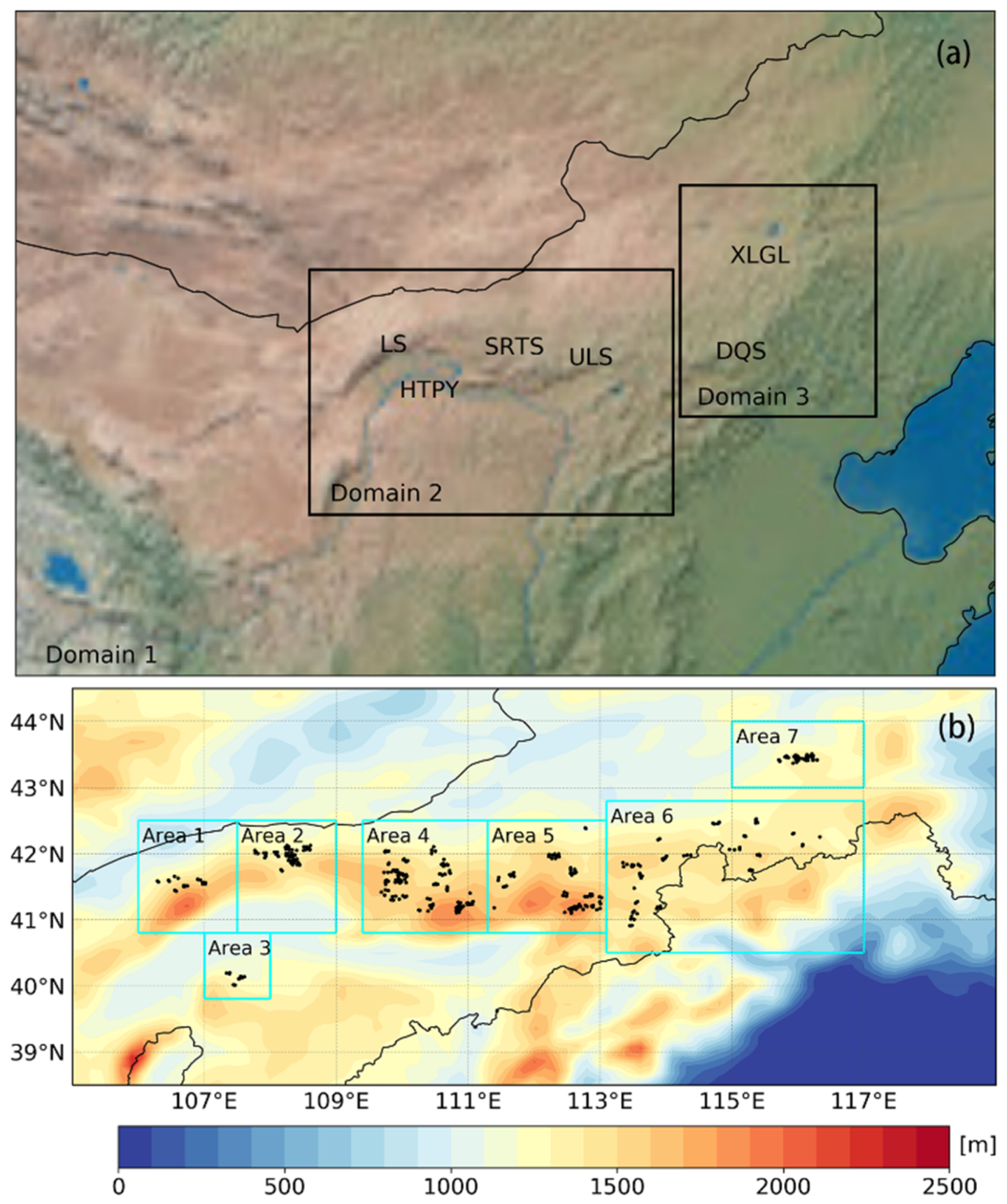
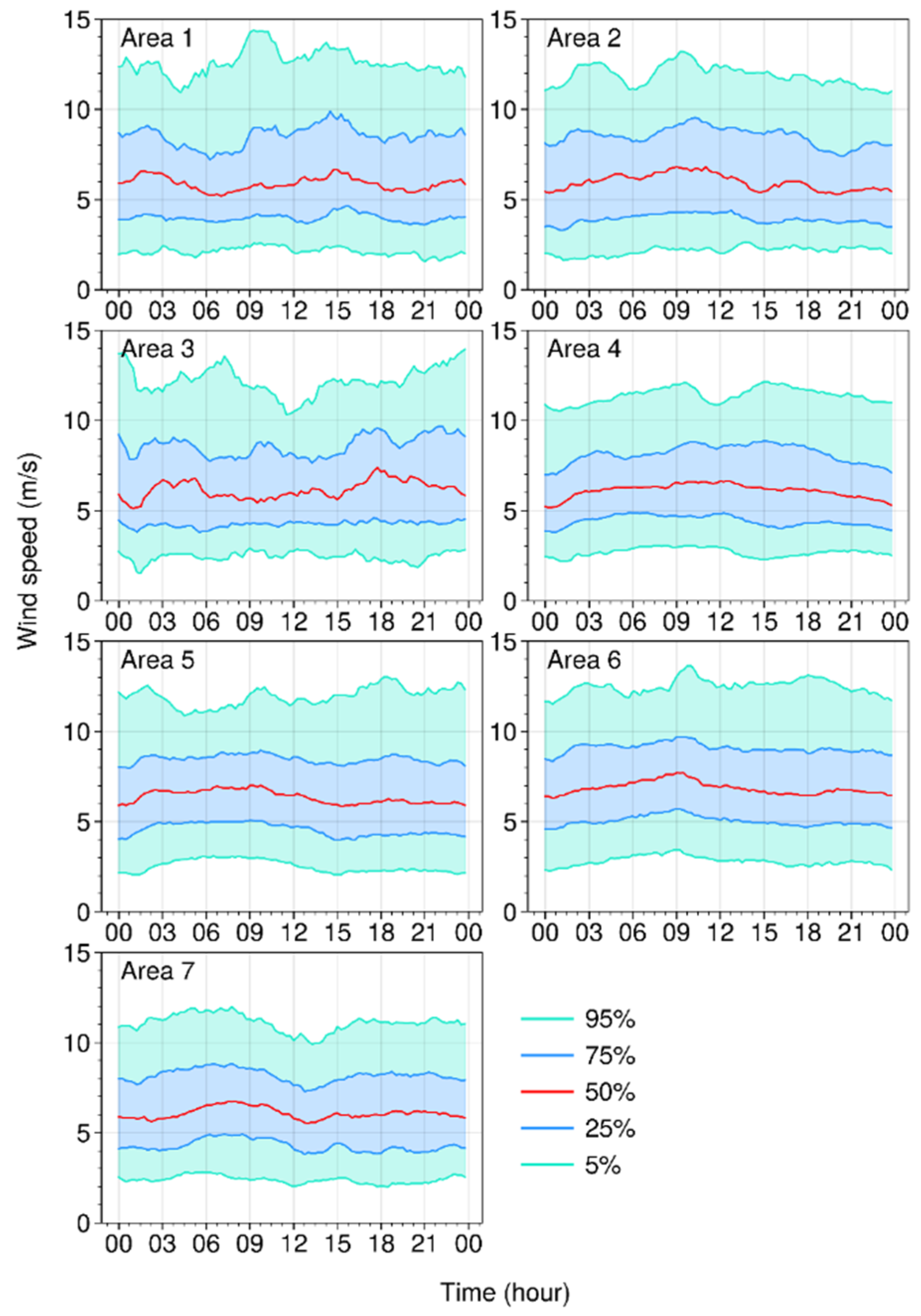
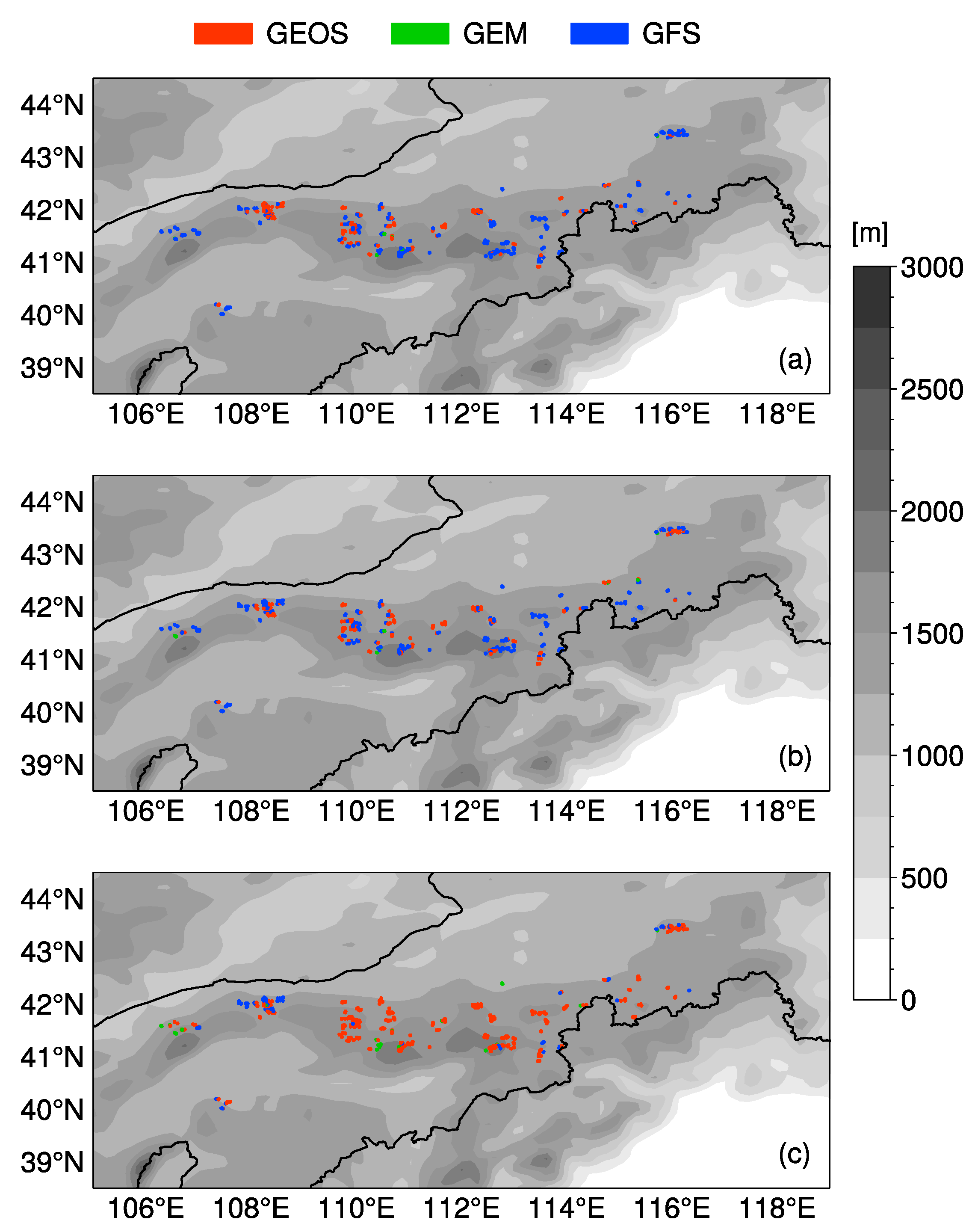
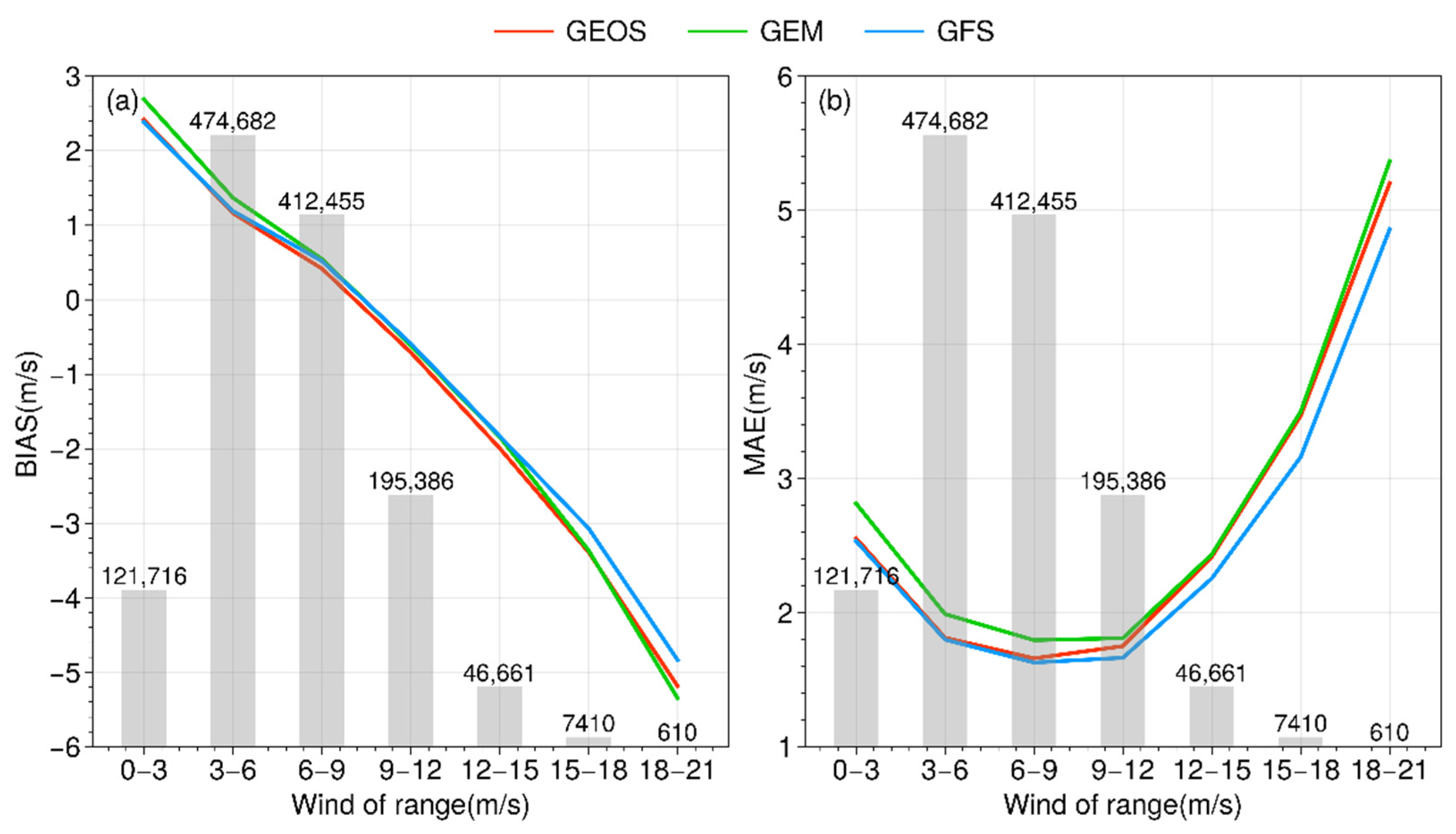
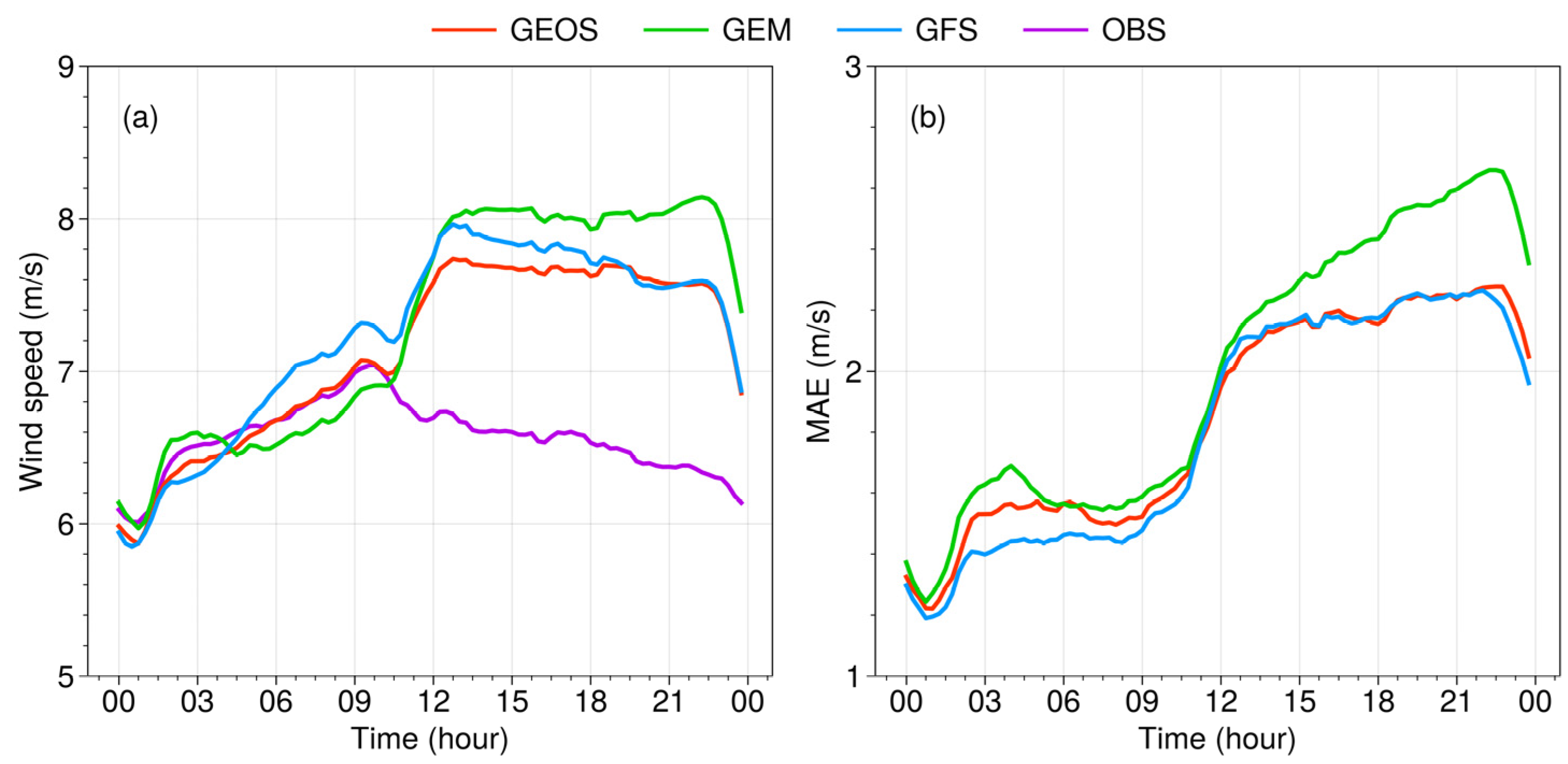
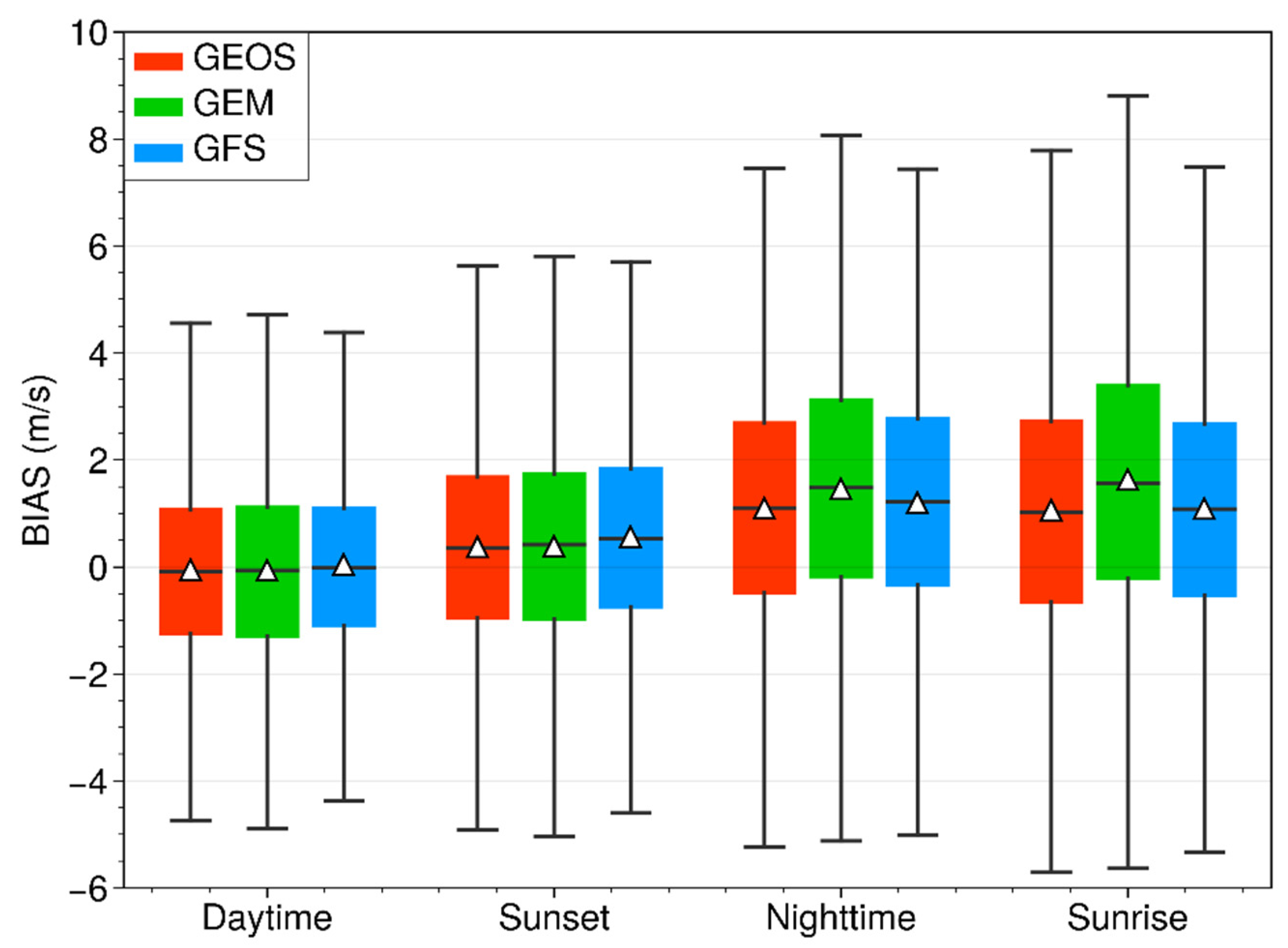
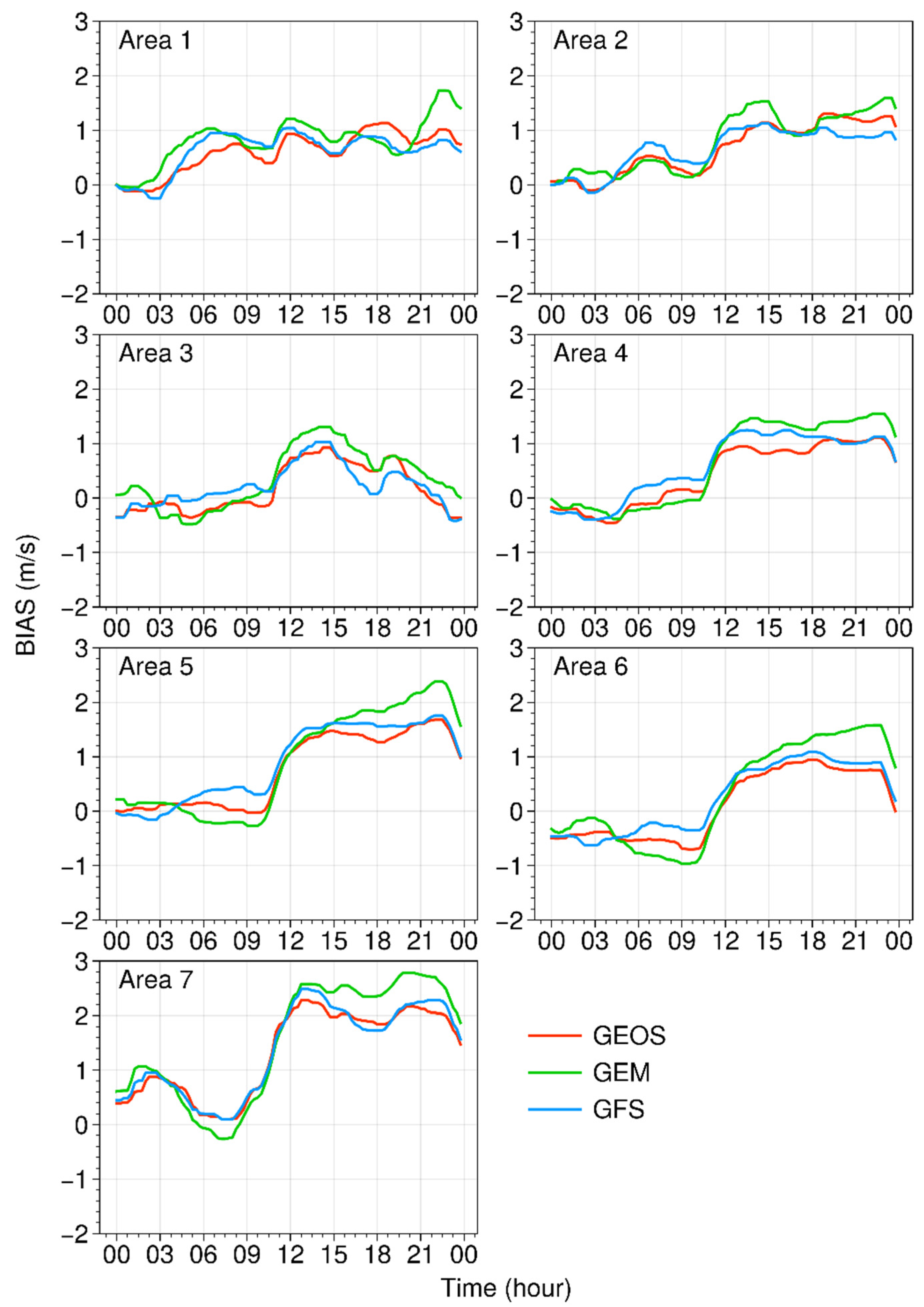
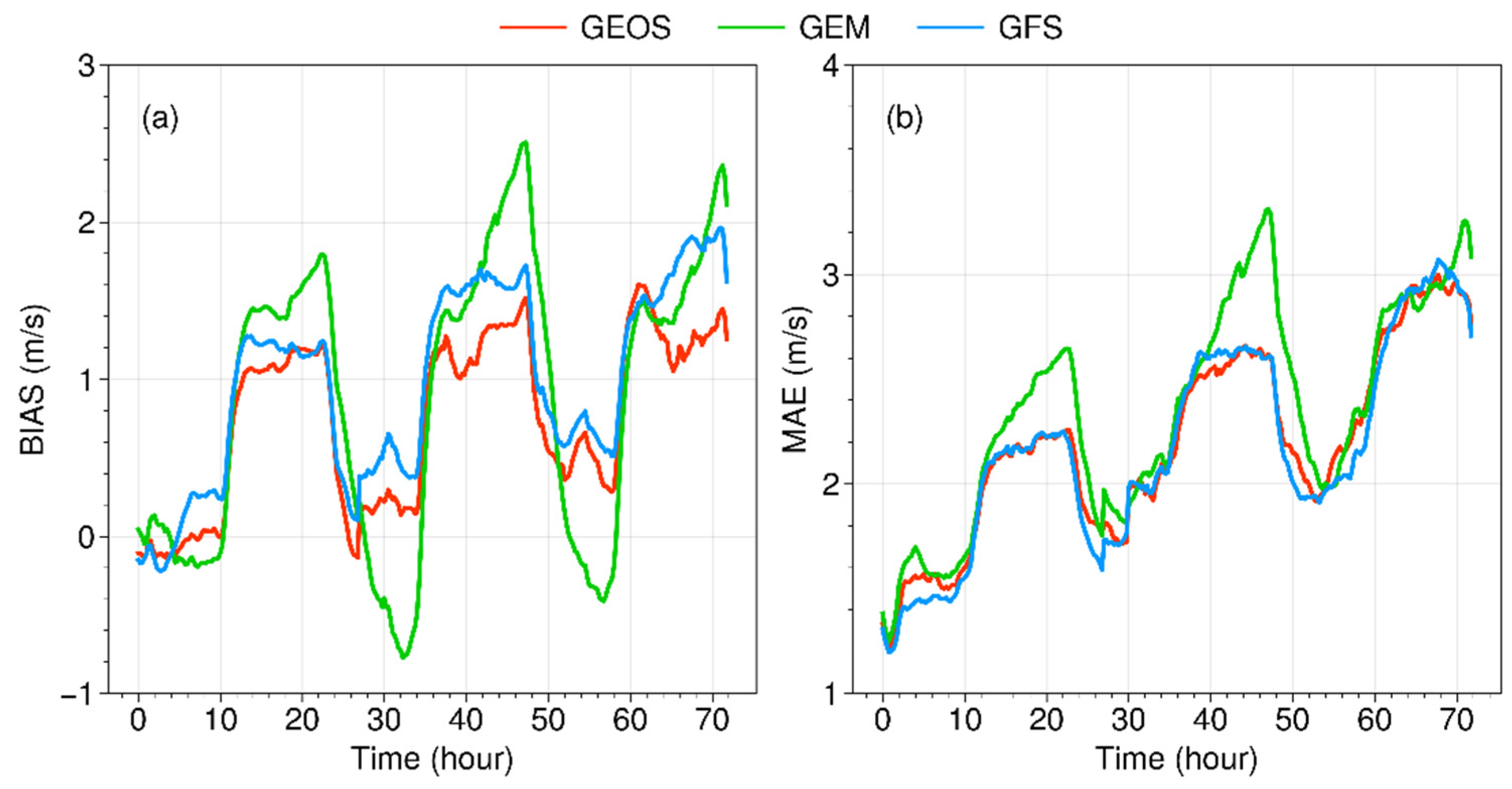
| Member Name | Member Perturbations |
|---|---|
| CTRL | YSU PBL [59] |
| BOU | BouLac PBL [60] |
| MYNN2 | MYNN 2.5 level TKE scheme [61] |
| MYJ | Mellor–Yamada–Janjic TKE PBL scheme [62] |
| SHS | Shin–Hong ‘scale-aware’ PBL scheme [63] |
| TEMF | TEMF (Total Energy Mass Flux) scheme [64] |
| UNW | UW boundary layer scheme from CAM5 [65] |
| GBM | Grenier–Bretherton–McCaa scheme [66] |
| QNS | Eddy-diffusivity mass flux, quasi-normal scale elimination PBL [67] |
| SKEBA | Stochastic kinetic energy backscatter scheme A |
| SKEBB | Stochastic kinetic energy backscatter scheme B |
| SKEBC | Stochastic kinetic energy backscatter scheme C |
| RRMG | Morrison Microphysics + Mellor–Yamada–Janjic PBL scheme |
| GEOS Group | GEM Group | GFS Group | ||||||||||
|---|---|---|---|---|---|---|---|---|---|---|---|---|
| Mean | Max | Median | Min | Mean | Max | Median | Min | Mean | Max | Median | Min | |
| CC | 0.68 | 0.66 | 0.62 | 0.58 | 0.64 | 0.63 | 0.58 | 0.53 | 0.70 | 0.67 | 0.65 | 0.61 |
| BIAS (m/s) | +0.56 | +0.75 | +0.60 | −0.05 | +0.76 | +0.91 | +0.79 | +0.15 | +0.67 | +0.91 | +0.69 | +0.04 |
| MAE (m/s) | 1.84 | 2.13 | 2.06 | 1.86 | 1.99 | 2.32 | 2.15 | 1.99 | 1.81 | 2.10 | 2.03 | 1.80 |
| GEOS Group | GEM Group | GFS Group | ||||
|---|---|---|---|---|---|---|
| NBPS */R * | NWPS */R | NBPS/R | NWPS/R | NBPS/R | NWPS/R | |
| CC | 141/34.3% | 81/19.7% | 8/1.9% | 318/77.4% | 262/63.7% | 12/2.9% |
| BIAS | 315/76.6% | 28/6.8% | 27/6.6% | 315/76.6% | 69/16.8% | 68/16.5% |
| MAE | 152/37.0% | 47/11.4% | 9/2.2% | 355/86.4% | 241/58.6% | 9/2.2% |
Publisher’s Note: MDPI stays neutral with regard to jurisdictional claims in published maps and institutional affiliations. |
© 2022 by the authors. Licensee MDPI, Basel, Switzerland. This article is an open access article distributed under the terms and conditions of the Creative Commons Attribution (CC BY) license (https://creativecommons.org/licenses/by/4.0/).
Share and Cite
Shi, J.; Liu, Y.; Li, Y.; Liu, Y.; Roux, G.; Shi, L.; Fan, X. Wind Speed Forecasts of a Mesoscale Ensemble for Large-Scale Wind Farms in Northern China: Downscaling Effect of Global Model Forecasts. Energies 2022, 15, 896. https://doi.org/10.3390/en15030896
Shi J, Liu Y, Li Y, Liu Y, Roux G, Shi L, Fan X. Wind Speed Forecasts of a Mesoscale Ensemble for Large-Scale Wind Farms in Northern China: Downscaling Effect of Global Model Forecasts. Energies. 2022; 15(3):896. https://doi.org/10.3390/en15030896
Chicago/Turabian StyleShi, Jianqiu, Yubao Liu, Yang Li, Yuewei Liu, Gregory Roux, Lan Shi, and Xiaowei Fan. 2022. "Wind Speed Forecasts of a Mesoscale Ensemble for Large-Scale Wind Farms in Northern China: Downscaling Effect of Global Model Forecasts" Energies 15, no. 3: 896. https://doi.org/10.3390/en15030896
APA StyleShi, J., Liu, Y., Li, Y., Liu, Y., Roux, G., Shi, L., & Fan, X. (2022). Wind Speed Forecasts of a Mesoscale Ensemble for Large-Scale Wind Farms in Northern China: Downscaling Effect of Global Model Forecasts. Energies, 15(3), 896. https://doi.org/10.3390/en15030896







